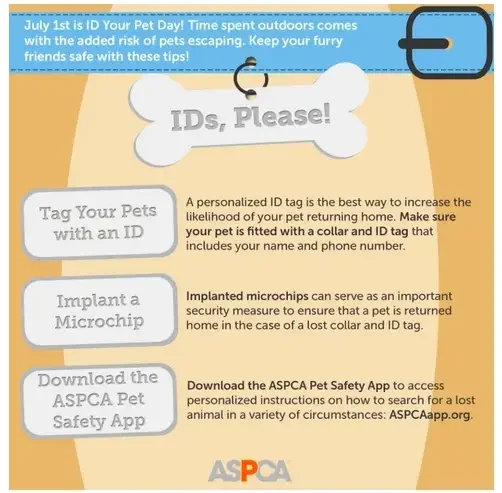While people look forward to Independence Day as a time filled with family-oriented fun and fireworks, for our four-legged friends the Fourth of July is faced by fear. Frantically searching for safety from the sights and sounds of popping pyrotechnics, more pets find themselves lost on July 4th than on any other date of the year. In advance of the fireworks, ID Your Pet Day strives to prepare pet lovers and prevent lost pets.

When is ID Your Pet Day?
ID Your Pet Day is observed every year on July 1. This pet holiday was created by the ASCPCA.
Related posts:
National Pet ID Week and National Lost Pet Prevention Month
How to ID Your Cat
The safest and most effective forms of identification for cats are microchipping combined with a breakaway collar that has an ID tag. Here’s a breakdown of each method and its advantages:
Microchipping
- Permanent Solution: Once a microchip is implanted under a cat’s skin, typically between the shoulder blades, it lasts for the lifetime of the cat.
- Universal Identification: If a lost cat is taken to a veterinarian or animal shelter, they will typically scan for a microchip as a standard procedure.
- No Physical Risk: Since the microchip is under the skin, there’s no risk of it getting caught on anything, as could happen with a collar.
- Updatable Information: If your contact information changes, you can update it in the microchip’s database without needing to change the chip itself.
- Proof of Ownership: In case of disputes over ownership, a microchip can serve as evidence, especially if it’s registered and updated.
- Cons: The main drawback is that someone who finds your cat casually (like a neighbor) might not be able to access the information without a chip scanner which generally means a trip to the vet or an animal shelter. Additionally, there’s a small chance of microchip migration, where the chip moves from its original implantation spot, although it’s still inside the animal and can be scanned.
Breakaway Collar with ID Tag
- Instant Information: Anyone who finds your cat can immediately see the tag and contact you without needing special equipment.
- Safety Mechanism: Breakaway collars are designed to release under pressure, reducing the risk of your cat getting strangled or stuck if the collar catches on something.
- Cons: Collars can be lost, and there’s still a risk, although minimal, of injury. Some cats also dislike wearing collars, and the information on the ID tag can wear away over time.
Using both methods simultaneously offers the best protection. The microchip provides a permanent form of ID, while the breakaway collar with an ID tag offers immediate contact information for anyone who might find your lost cat.
Tips from ASPCA
Cat lovers can learn handy tips for protecting cats and canines with help from an ASPCA infographic which states that:
- A cat or dog who wears a personalized ID tag is more likely to be returned to his or her home. Your furry friend should be fitted with a collar and an ID tag which displays your name and phone number.
- In the event of a lost collar and ID tag, an implanted microchip is another method to ensure that you are reunited with a barking buddy or purring pal who has gone missing.
- Pet parents can access personalized instructions on the most efficient way to search for a lost companion animal in varying circumstances by downloading the ASPCA Pet Safety App.

More Cat Holidays
ID Your Pet Day is just one of many summer cat holidays; you also might enjoy these:
National Craft for your Local Shelters Day
- Tyler Bass Fans Donate to Cat Adoption Group - January 24, 2024
- Saint Gertrude of Nivelles, Patron Saint of Cats - January 19, 2024
- Offensive Tackle Daniel Faalele’s Defensive Play for Animal Rights - December 27, 2023
